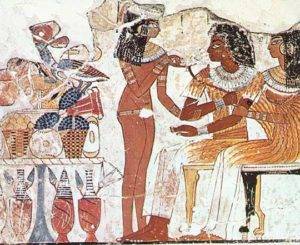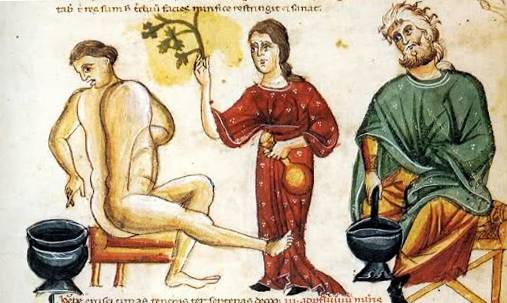Dr. Caterina Maci
Veterinarian – Second level Master in Phytotherapy – University of Siena
Introduction
Plants can be considered the alchemists of nature, experts in the transformation of sunlight, water and earth into precious substances, abilities that man can only partially imitate (taken from Botany of Desire , Michael Pollan).
Plants contain numerous chemical constituents that are used for nourishment and the formation of their systems and tissues, as well as to defend themselves from the surrounding environment and to interact with it.
Since ancient times, man has understood that the substances produced by plants could indeed be poisonous and harmful, but at the same time be curative and help him survive in the environment where he was. The first men were gatherers of seeds, fruits and herbs which served them as nourishment. The observation, by the human species, of the behavior of the animals with which it shared the natural spaces was fundamental, which fed on particular plants, fungi or minerals to avoid nutritional deficiencies or to treat themselves from parasites and infectious agents.
To give examples, to date, our dogs and cats eat a particular type of grass in case of nausea and the Brazilian parrots, the Macaws, ingest clay in order to eliminate the toxins produced by certain foods, which are part of it. of their diet.
The relationship between man and plants, over the millennia, has made it possible to develop the first medical and therapeutic knowledge evolved up to the present day, which are grouped under the term of Phytotherapy.
An ancient medicine
All knowledge and knowledge arises from the need to satisfy needs: it is thus that many millennia ago man, from prehistoric times onwards, was able to acquire information and experience on the use of plants for curative purposes, to survive in an environment similar to him. hostile, where however nature also offers solutions and help.
At first he observed his own kind and other animals, noting which plants could be poisonous and which were useful for healing wounds, pain or keeping out harmful insects. We can therefore affirm that in the long period of prehistory man, thanks to the repeated observation of the effects obtained on particular diseases, develops, albeit with a rudimentary practical experimentation, the first knowledge of the therapeutic virtues of numerous medicinal plants. From empiricism and tradition, therefore, phytotherapy is born (F. Capasso – Rational use of herbal drugs ). At first this knowledge was handed down orally and explained by associating the divinities or metaphysical forces of good and evil, in parallel with the “magical virtues of plants”. Subsequently, the first written documents to define the medicinal properties of plants begin to emerge and together with the first civilizations the concept of pharmacology linked to the plant kingdom was born.
It is not easy to specify when the art of healing began to rely on the medicine of facts or evidence that the same plant, or a part of it, could be useful in a therapeutic or harmful sense, depending on the dose or individual conditions of the patient.
However, there are four main medical-herbal cultures which, despite their geographical isolation, with no contacts between them, have used similar plant species to treat the same diseases: the Chinese, Indian (Ayurvedic), European (including Egyptian and Middle Ages) cultures. oriental) and Amerindia (of the American indigenous peoples).

1) The Chinese phytotherapeutic tradition reports the first great herbarium written, around 3000 BC, by Shen Nung called Pen Ts ao Ching which reports the description of numerous medicinal plants and 237 herbal prescriptions based on herbs including ephedra and opium poppy. The emperor and expert herbalist Shen Nung (Chin Nong) is the one who is credited with the birth of agriculture in China and the use of tea, taking the name of “Divine Healer”. Li Shih-Chen (Li Shizhen), a Chinese naturalist, wrote the Pen Ts ao Kang Mu (Great Herbarium) at the end of the 16th century, comprising numerous medicinal plants and herbal formulations. At the base of the Chinese medical conception is the Tao, that is the universe itself which is represented in the entirety of the yin and yang or of the opposites, which, being in balance, can express the reality and harmony of Nature. Plants also fall within this philosophy by classifying themselves into yin and yang.

2) Indian medicine takes the name of “Ayurvedic”, which derives from the Sanskrit ayur (life) and ved (knowledge). It is descended from the four Indian books of wisdom, called the Vedas. Among these, the Rig Veda describes medicaments composed of herbs, including cinnamon, ginger and senna. Ayurveda is a holistic medicine, that is, it examines not only the body but also the mind, the spirit and the environment in which the living being is, as a single whole that falls ill when its components are not in balance or harmony. In a state of illness all the above elements must be examined starting from the mind, in which the awareness of one’s condition develops, as the starting point for the healing process.

3) The European medical culture was born in the Mediterranean basin with the Egyptian civilization which then influenced all the others that followed. The first written source of botanical and medical knowledge is the Ebers papyrus found in Luxor and dating back to 1500 BC. It contains herbal formulas based on more than 500 plants, of which almost a third still appears in Western pharmacopoeias. In the Egyptian civilization medicine and religion are united, as is understood by the revered gods. For example, Osiris was the god of vegetation and Isis, his sister and wife, had revealed the secrets of medical care to humanity so much so that the sick turned to her to invoke healing from suffering. The caduceus, which as it is known, is still the symbol of medicine today, is the stick wrapped in a snake that the Egyptian god Toth holds in his right hand in his representations.
The Egyptian civilization then influenced the Greek one for medical knowledge and practice. The philosopher Aristotle (4th century BC), devoted himself to the study of botany, in addition to its most famous philosophical and scientific disciplines. Again in Classical Greece Hippocrates (460-370 BC) founds the clinical method for which he is considered the father of medicine. He was a doctor and priest in Cos, in the temple dedicated to Asclepius, the god of medicine. Asclepius, according to the myth, is the son of Apollo and Coronis, and was born in Epidaurus and was killed by Jupiter, jealous of his success in curing the sick. Hippocrates is the first to use a modern approach to the patient, that of diagnosis-prognosis-therapy, analyzing the disease and applying the codified rules learned in the temple where the Asclepiads or priest doctors treated the faithful-patients with natural remedies, including , according to the cult of Asclepius, snakes were worshiped, considered sacred animals. There are plants whose family of belonging today takes its name from Asclepio, the family of the Asclepiadaceae, typical of tropical and subtropical regions.
After the foundation of Alexandria of Egypt with Alexander the Great in 331 BC, Greek medicine saw its period of maximum splendor thanks to the Alexandrian School with its scholars from all over the Middle East.
Dioscorides in the first century AD, a native of Hellenic Cilicia (today Turkey), then a province of the Roman Empire, classified and brought into conformity the effects of plants and was employed as a doctor under Nero. He wrote the De Materia Medica, the first true European herbarium, where he classified the therapies of the time and over 600 medicinal plants, many of which are still used. Each plant is described, as described, the place of growth, the methods of use for medicinal purposes and the effects it produces on the human body.
Among the authors worth mentioning in ancient Rome, we must mention Pliny the Elder (1st century AD), a scholar of the plant kingdom and its use for the treatment of diseases in his work Naturalis Historia.
Galen, worthy successor of Hippocrates, personal doctor of Marcus Aurelius and founder of the Galenic medical school, is interested in remedies based on medicinal plants according to the polypharmacy system or mixed plant preparations to treat all aspects of diseases.
After the fall of the Roman Empire it is the Arabs who continue the medical study of plants with the contribution of illustrious scholars such as Giovanni Mesuè (Abu Zakaryya Yuhanna Ibn Masawayh), and Avicenna (Abu Ali al-husayn b. Abd Allah b).
During the Middle Ages, phytotherapy was associated, through concepts of superstition, with astrology and magic with the belief that herbal remedies should be effective, not by their nature but by the action of supernatural components.
Around the year 1000, the monastic structures dedicated themselves to medical assistance for sick pilgrims and it was with the birth of the Cistercian abbeys that medicinal plants were cultivated in their gardens and phytotherapeutic preparations were produced. During this period in Europe the abbess Hildegard (1098-1179) from Bingen, author of a herbal treatise, “Hildegard’s medicine” is considered the first German herbalist-doctor. Subsequently, St. Benedict of Norcia around 534 dc called His Rule founded the Monastery of Montecassino.
In 1498 in Florence the first pharmacopoeia, the Florentine Cookbook, was published in the vernacular by the University of the Apothecaries, containing indications, dictates for the collection, preparation and storage of drugs and a form of galenic preparations.

4) With the discovery of the Americas , it was then possible to take advantage of the properties of plants different from the European ones but equally important that have contributed to the evolution of modern medicine. Even today in South America there is the figure of the curanderos, connoisseurs of the numerous plant species such as those relating to the Andean Cordillera. For the tradition of the North American peoples, however, much information has been lost due to their persecution and their characteristic of non-sedentary social organization.
However, the term “Phytotherapy” appears for the first time in a treatise by Henry Leclerc (1870-1955), Precis de Phytotherapie which will be used later by Rudolf Fritz Weiss (1895-1992) in his Lehrbuch der Phytotherapie, still in use today common.
During the industrial revolution, with the progress of technology and the removal from the countryside, man has unfortunately changed and lost the traditional use of plants which today, however, in recent times, in the face of new diseases, is rediscovered and strengthened thanks precisely to modern technologies and scientific knowledge.
Modern phytotherapy
For its historical evolution, phytotherapy is the symbol of popular medicine that since the appearance of man on Earth uses natural substances that are found in the environment and that are produced by nature. Modern medicine still uses plants in the laboratory for the synthesis and preparation of drugs. To give examples: morphine is extracted from opium poppy, aspirin is a derivative of willow bark or cortisone, produced by plants such as agaves and yams (diosgenin is extracted from the bulb of the latter, from which corticosteroids, oral contraceptives and sex hormones are obtained).
Through experimental tests, the plants are selected to be authorized for use in the preparation of drugs, respecting the principles of efficacy and safety like any other substance.
What are the benefits of plants?
A key role in the pharmacological action of plants is the phytocomplex , that is the presence of several molecules together, main and secondary, which determine important effects on the processes of absorption, distribution, metabolism, excretion and toxicity of the phytotherapic.
In fact, it has been observed that the phytocomplex, precisely because of these characteristics, manages to have a greater and more prolonged distribution of its pharmacological effect over time, uses different elimination routes (interaction with different excretory organs), has better intestinal absorption, less toxicity and more target organs, as well as less resistance phenomena.
Specifically , the action of plant phytocomplexes is modulated to act in equilibrium with the cellular activity of living beings since it is similar by interaction to the activity of the plant cells themselves. Phytotherapy is in effect the study of plant chemistry, which we can adapt to the specific problems of the patient, respecting his physiological balance.
Nature helps us
Phytotherapy can not only contribute to solving health problems , but above all it can represent an aid for the prevention of pathological states, keeping our body healthy and in balance with the world around us, both physical and mental. Nature offers its living beings, including us, the possibility of adapting to the environment in which we live and with which we must maintain the symbiotic relationship in order to feel good . The substances processed by plants are very different and complex compared to those that man manages to prepare with synthetic products, moreover the plants are alive and their internal mechanisms are similar to those of the human body: they are the biological link with the world that created us.

